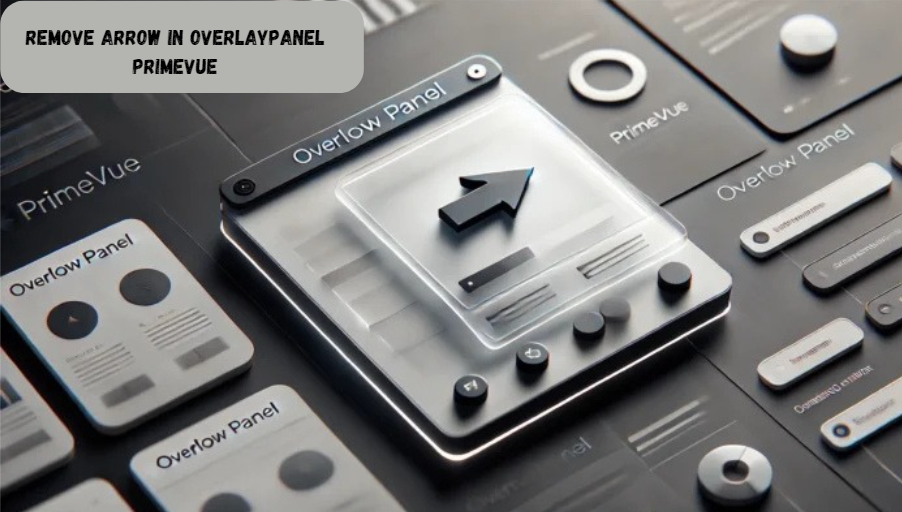PrimeVue is a popular component library for Vue.js, offering various UI elements designed to enhance web applications. Among these components, the OverlayPanel is widely used for its functionality and aesthetic appeal.
However, one common question developers encounter is how to remove the arrow in the OverlayPanel in PrimeVue. This guide delves into the steps, configurations, and customizations necessary to remove the arrow from the OverlayPanel component in PrimeVue, providing a complete solution that goes beyond the information typically available online.
Contents
Introduction to OverlayPanel in PrimeVue
The OverlayPanel component in PrimeVue is a versatile, highly customizable overlay container used to display content like lists, menus, forms, and even tooltips. It is designed to be triggered on user actions such as clicking a button or hovering over an element. The OverlayPanel is often accompanied by a directional arrow that visually indicates the relationship between the trigger and the panel, providing a better user experience.
While this arrow can be useful, many developers prefer a cleaner, minimalistic design where the arrow is unnecessary or distracting. This is especially true for modern UI designs where simplicity and sharpness are paramount. Hence, understanding how to remove the arrow in OverlayPanel PrimeVue is an essential skill for front-end developers looking to fine-tune the visual aspects of their applications.
Why Remove the Arrow in OverlayPanel?
Removing the arrow from the OverlayPanel in PrimeVue serves both functional and aesthetic purposes. Here are several reasons why you might want to remove it:
1. Simplified User Interface Design
In minimalistic design approaches, every extra visual element is scrutinized. The arrow might not align with the overall flat and sleek design style. By removing it, the UI can appear more modern and less cluttered.
2. Customization and Brand Consistency
In many branded applications, overlays and dropdowns are designed to match a specific theme or design language. The default arrow might not fit the brand’s color palette or visual language, so removing it can allow more flexibility in styling.
3. Enhanced Responsiveness
On small screens, especially in mobile applications, the arrow can interfere with the optimal placement of the OverlayPanel. Removing the arrow can make the OverlayPanel look more adaptable to different screen sizes.
4. Functional Constraints
Sometimes the arrow’s position or alignment may not work well with other UI components, causing issues like misalignment or overlapping content. Removing the arrow eliminates potential layout conflicts.
Step-by-Step Guide: How to Remove the Arrow in OverlayPanel PrimeVue
To remove the arrow in the OverlayPanel component of PrimeVue, you’ll need to modify the component’s default styling and behavior. Follow these steps to implement the changes effectively.
Step 1: Analyze Your Design Requirements
Before diving into the code, it’s essential to consider your design requirements:
- Do you want to remove the arrow from all OverlayPanels or just specific ones?
- Are you using custom themes that might affect the appearance of the OverlayPanel?
- Do you need any fallback styles or browser compatibility?
By answering these questions, you will better understand how extensive your customization needs to be.
Step 2: Review the OverlayPanel Configuration Options
PrimeVue provides various configuration options for the OverlayPanel component, but there is no built-in property to hide the arrow directly. The arrow is usually controlled by the component’s CSS. Thus, to remove it, you need to customize the component’s styles.
Review the component’s documentation and default CSS styles in PrimeVue to identify the class responsible for rendering the arrow. Typically, it will look something like this:
cssCopy code.p-overlaypanel-arrow {
position: absolute;
/* Additional arrow styles */
}
Step 3: Custom CSS Approach to Remove Arrow
The most straightforward way to remove the arrow is by overriding the default CSS classes responsible for rendering the arrow. To do this:
- Locate the Arrow in the OverlayPanel’s CSS: The class responsible for the arrow is usually
.p-overlaypanel-arrow. This class controls the appearance and positioning of the arrow. - Override the CSS: You can hide the arrow by setting the
displayproperty of the.p-overlaypanel-arrowclass tononein your custom styles.
cssCopy code.p-overlaypanel-arrow {
display: none !important;
}
This approach effectively removes the arrow, leaving the rest of the OverlayPanel intact.
- Apply Custom Styles: If you’re using a scoped style within a Vue component, make sure your custom CSS is properly scoped. Otherwise, you can place this in your global stylesheets.
Step 4: JavaScript Methods for Arrow Removal
While CSS offers a quick solution, JavaScript can provide additional flexibility if you want to dynamically control when the arrow is shown or hidden.
- Add Conditional Rendering: You can use Vue’s conditional rendering to apply specific classes or styles when needed. For example, you can bind a class dynamically based on a condition:
vueCopy code<OverlayPanel :class="{ 'no-arrow': hideArrow }">
<!-- Panel content goes here -->
</OverlayPanel>
- Manage Arrow Visibility with Vue Data: Use a
hideArrowproperty in your component’s data or Vuex store and toggle the value based on user actions or component states. This can be useful if you need to remove the arrow only under specific circumstances.
javascriptCopy codeexport default {
data() {
return {
hideArrow: true
};
}
};
- Control Arrow Removal Through Event Listeners: If your panel appears based on specific user actions, you can trigger the arrow’s visibility based on events. For example, you might hide the arrow when the panel is shown:
javascriptCopy codemethods: {
onShow() {
this.hideArrow = true; // Dynamically hide the arrow
}
}
Step 5: Testing and Optimization
After implementing the changes, you should thoroughly test your OverlayPanel across different devices and browsers to ensure that the removal of the arrow does not affect functionality or layout.
- Test Responsiveness: Ensure that removing the arrow does not negatively impact the responsive design, particularly in mobile or tablet views.
- Cross-Browser Compatibility: Test the OverlayPanel in various browsers (e.g., Chrome, Firefox, Safari, Edge) to ensure consistent behavior across platforms.
- Optimize for Performance: Ensure that the customizations do not significantly affect page load times or performance. Heavy CSS or JavaScript manipulations can sometimes slow down component rendering, particularly in large-scale applications.
Best Practices for Customizing OverlayPanel
When working with PrimeVue components, it’s crucial to adhere to best practices to ensure that your customizations are sustainable and scalable:
- Avoid Direct DOM Manipulation: Always prefer using Vue’s reactivity system and built-in features (e.g.,
v-bind,v-if,v-show) instead of directly manipulating the DOM. - Scoped CSS for Local Changes: If you are modifying styles for specific OverlayPanels, use scoped CSS to prevent unintentional style leaks that might affect other parts of your application.
- Maintain Accessibility: Ensure that any changes you make, including the removal of the arrow, do not negatively impact accessibility. Proper focus management, keyboard navigation, and screen reader support should always be prioritized.
Common Mistakes to Avoid
- Not Testing on Mobile: Removing the arrow without testing how the OverlayPanel looks on smaller screens can lead to design issues. Always ensure that the layout adjusts well across all device sizes.
- Overriding Global Styles: Overriding global styles for the OverlayPanel without scoping them can unintentionally affect other parts of your application, especially if you’re using multiple OverlayPanels with different designs.
- Forgetting Accessibility: Removing the arrow might make the relationship between the trigger and the panel less clear for users with disabilities. Always provide alternative visual cues or ARIA labels to maintain accessibility standards.
Alternative Solutions and Plugins
If removing the arrow in the OverlayPanel is not enough for your use case, you may explore some alternative approaches:
- Use a Custom Tooltip or Dialog: Instead of the OverlayPanel, consider using PrimeVue’s Tooltip or Dialog components if they better suit your design without requiring as much customization.
- Third-Party Vue Libraries: There are other third-party libraries like Vuetify or Element UI that offer similar overlay components with more extensive customization options. If PrimeVue’s OverlayPanel does not fit your project’s requirements, you may explore these alternatives.
- PrimeVue Community Extensions: PrimeVue has a vibrant community, and several extensions and plugins are available that might offer more advanced OverlayPanel configurations, including options to remove or customize arrows more easily.
FAQs
How can I revert back to the default OverlayPanel with the arrow?
To revert to the default OverlayPanel, simply remove or comment out the custom CSS rules that hide the arrow. The default styles will automatically restore the arrow.
cssCopy code/* Remove this rule to restore the arrow */
.p-overlaypanel-arrow {
display: none !important;
}
Can I customize other parts of the OverlayPanel along with the arrow?
Yes, PrimeVue allows extensive customization of the OverlayPanel. You can modify the background color, border, shadows, animations, and more through custom CSS or by leveraging PrimeVue’s built-in theme customization options.
Is removing the arrow in OverlayPanel PrimeVue compatible with all browsers?
Removing the arrow using CSS, as outlined in this guide, is compatible with all modern browsers, including Chrome, Firefox, Edge, and Safari. Always test in older browsers if backward compatibility is a concern for your project.
conclusion
In conclusion, removing the arrow in the OverlayPanel of PrimeVue is a relatively simple task with significant design benefits. By following this guide, developers can implement a cleaner, more modern UI that enhances the user experience while maintaining performance and accessibility standards.




